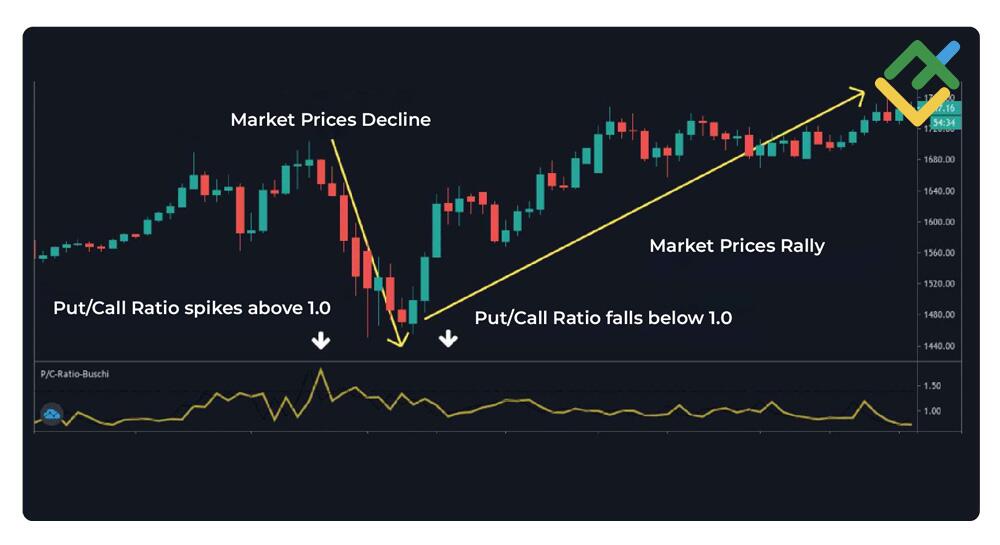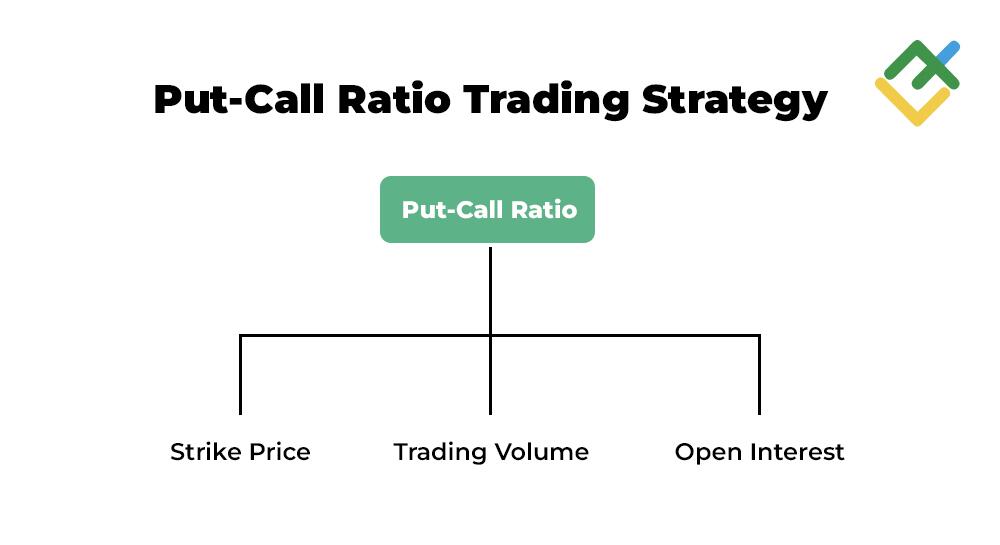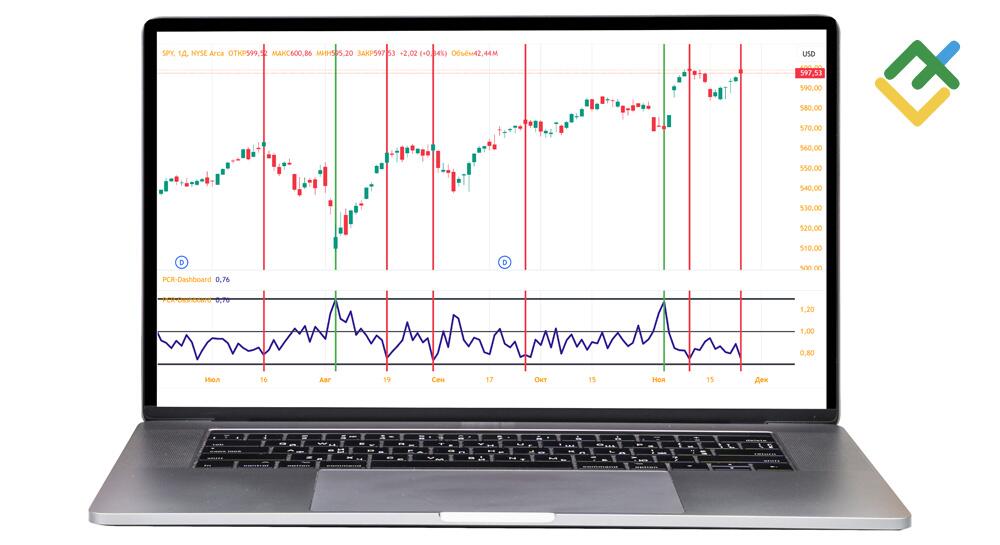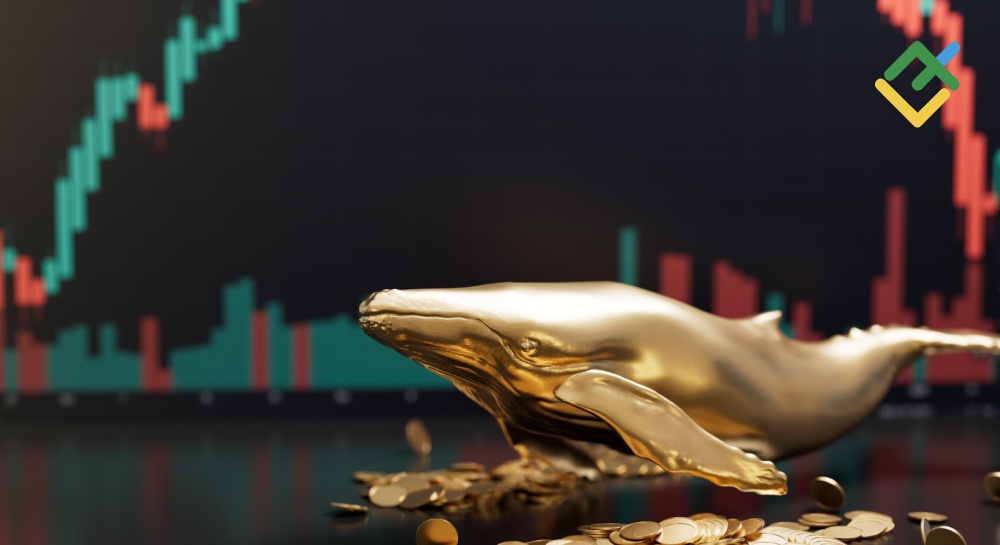
The Put/Call Ratio is one of the most popular tools for analyzing market sentiment. This indicator is widely used in the equity market. It reflects the ratio of trading volumes of puts and calls of equity and index options, which in turn determines the current trend and bullish or bearish market sentiment. Market sentiment refers to the attitude or mood of investors regarding a stock or the entire financial market. The put-call index is used on many exchanges, such as the Chicago Board Options Exchange (CBOE).
The put/call ratio gauges the market’s risk appetite and is often used as a sentiment indicator. For example, if the value is low, traders can expect an increase in the asset’s quotes. On the contrary, if the value is high, a decrease is looming. Interpreting its signals is important when making investment decisions and developing trading strategies.
The article covers the following subjects:
Major Takeaways
- The put/call ratio is an indicator that shows put volume relative to call volume.
- A low indicator value signals a bull market, while a high value suggests a bear market.
- The Chicago Board Options Exchange (CBOE) provides data on stock options and indices to assess the market.
- Extremely high or low values of the ratio help identify potential pivot points.
- Smoothing with moving averages helps identify long-term trends.
- The ratio is used to analyze the stock market and predict trend reversals.
- The put/call ratio enables traders to ascertain whether an asset is overbought or oversold.
What Is the Put-Call Ratio?
The put/call ratio was developed by Martin Zweig and introduced through Barron’s article in 1971. For over 50 years, successful investors have used the put/call ratio as a tool for identifying market sentiment. When the article was published, data was collected from over-the-counter traders as there was no established exchange at that time. In 1974, the Chicago Board Options Exchange (CBOE) was founded, enabling investors to access daily data directly from the exchange.
The put/call ratio is a measurement used to compare the trading volume of put options that give the buyer the right to sell the underlying security with that of call options that give the buyer the right to buy the security. In other words, this ratio is calculated by dividing the number of traded put options by the number of traded call options, gauging market sentiment. When investors buy put options, it indicates a risk-hedging strategy. Conversely, when they purchase call options, it suggests a bullish outlook on stocks and other financial instruments.
Interpretation of the Put-Call Ratio
The put/call ratio is frequently utilized as an indicator of market sentiment, providing insight into prevailing expectations and the associated trading risks. A value exceeding 1 indicates a bearish market outlook, while a ratio value below 1 suggests a bullish sentiment.
Smooth Analysis for Reliable Insights
Many traders and analysts employ moving averages to enhance the precision of their interpretation of the put/call ratio. This method helps to smooth the data by removing short-term fluctuations, providing greater clarity on long-term trends. Moving averages allow investors to gain a more accurate understanding of market conditions by filtering out market noise.
For instance, if the put/call ratio is above a 20-day moving average, it may signal a trend reversal. This scenario often occurs in oversold or overbought conditions when the market is likely to undergo a correction. By analyzing trends using these techniques, traders can improve the accuracy of their interpretations and avoid false signals. This method allows traders and investors to make more informed trading decisions and build an investment portfolio aligned with market sentiment.
Extreme Values and Market Extremes
The put/call ratio’s extreme values are an important indicator that can be used to identify market extremes. A sudden spike in the indicator signals an excessive bearishness, which may indicate an oversold asset. In such cases, there is a high probability of a trend reversal, as extreme pessimism often precedes correction or significant price growth. Therefore, traders may consider opening long positions.
Conversely, an extremely low ratio points to bullish market sentiment. This could indicate an overvaluation of the asset and an impending pullback. In addition, such extreme values of the indicator are often accompanied by elevated volatility. During such periods, traders should prepare for unexpected reversals and use appropriate trading strategies to minimize risks and enhance profitability.
Trading Tips and Strategies
The put/call ratio is a key indicator of market conditions. It provides insight into the prevailing market sentiment by assessing the proportion of put and call option trades. When used correctly, traders can accurately predict market directions and mitigate the risks associated with sudden price changes.
- Monitor extreme values. The index is used as a contrarian indicator to gauge bullish and bearish extremes. Significant fluctuations in the indicator may point to an overbought or oversold market condition, which often precedes a potential market reversal.
- Use additional indicators. To enhance the reliability of signals, integrate the ratio with analytical tools such as the Momentum, moving averages, and trading volume indicators, or the price at which the holder can buy or sell the underlying asset if they choose to exercise the option, also known as the strike price. Open interest indicators can be used as an additional supply and demand indicator, enabling you to make more accurate forecasts.
- Analyze historical data. Monitor how the ratio changes in different market situations. Analyzing this market data allows you to gain a deeper understanding of its impact on the market, identify patterns, and determine the threshold value for each stock. This is particularly beneficial when making forecasts in highly volatile market conditions.
Strategy 1: Using Extreme Values
When the put/call ratio is high, traders usually look for entry points into long positions, anticipating an upward market reversal. This occurs when the volume of put trades significantly exceeds that of call trades, indicating a prevailing bearish sentiment.
As a rule, a strong bear market points to an oversold condition when the price of an asset has already declined sufficiently to attract large buyers, including contrarian investors who use the put-call ratio as a contrarian sentiment indicator to determine when market participants are getting overly bullish or too bearish. Historically, such periods of time often precede a recovery or even a significant price increase on the chart. As a result, traders tend to open long positions.
In addition to the put/call ratio, it is important to consider other market data provided by stock exchanges, such as trading volume or sentiment indicators. For instance, the RSI (Relative Strength Index) measures the speed and magnitude of a security’s recent price changes, and its values can reinforce the conclusions drawn from put-call ratio readings.
Strategy 2: Trend Confirmation
As long as the put/call ratio declines against sustained price growth, bullish sentiment among market participants will remain. In a market environment where the volume of call options is higher than that of put options, the price is expected to rise.
As a rule, traders perceive a reduction in the ratio as a bullish signal, particularly when additional indicators confirm this signal.
Furthermore, the put/call ratio can be employed to ascertain potential resistance and support levels. A consistent decline in the ratio in tandem with a bullish market often coincides with a reduction in volatility, creating an especially favorable environment for trading.
Conclusion
The put/call ratio is a versatile tool that can be plotted on any chart. Traders and investors widely use it to analyze market sentiment and make informed decisions. This indicator is particularly helpful in periods of uncertainty or highly volatile market conditions. It can be used to ascertain whether the market is overbought or oversold, signaling a trend reversal.
For instance, an elevated coefficient may suggest that market participants are overly pessimistic, often preceding an uptrend. Conversely, an exceedingly low indicator signals market optimism, which may indicate a decline in quotes in the near term. However, these values reveal the primary drawback of the tool as it belongs to leading indicators.
In addition, moving averages help smooth short-term price fluctuations, reducing market noise. Traders employ MAs to get more precise signals. Moreover, they are frequently used by investors and traders to identify sustainable trends and avoid false signals.
In conjunction with other analytical techniques and indicators, the put/call ratio allows traders and investors to build reliable strategies, mitigate risks, and enhance profitability.
Put-Call Ratio FAQs
The put/call ratio measures the correlation of the trading volume of put options to call options. It reflects the level of optimism or pessimism among market participants.
This is an indicator released by the Chicago Board Options Exchange (CBOE) that analyzes put and call option trading volumes to gauge market sentiment.
A PCR below 1 is considered bullish because the volume of call options prevails. Values above 1 are considered bearish.
A value below 1 indicates that traders opt for call options, which implies that they anticipate an increase in the trading asset’s price.
A value above 1 signals an increased demand for put options, which indicates a bearish market sentiment. In such a situation, traders tend to open short positions.
The put/call ratio indicates an oversold market condition when its value reaches extremely high levels, signaling excessive pessimism and the potential for growth in quotes in the near future.
The content of this article reflects the author’s opinion and does not necessarily reflect the official position of LiteFinance. The material published on this page is provided for informational purposes only and should not be considered as the provision of investment advice for the purposes of Directive 2004/39/EC.
{{value}} ( {{count}} {{title}} )
This post is originally published on LITEFINANCE.










